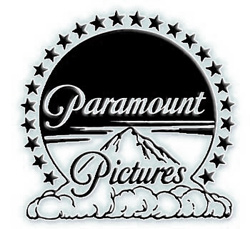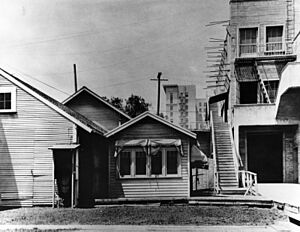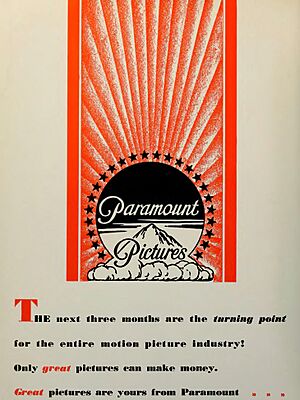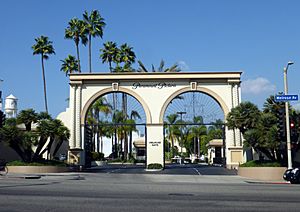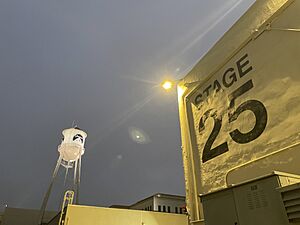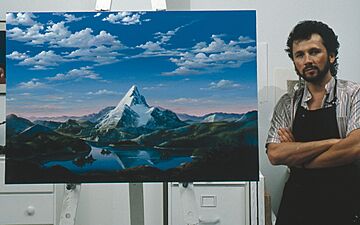Paramount Pictures facts for kids

Logo used since 1967
|
|
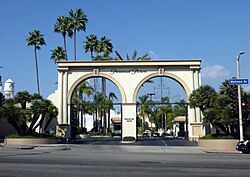
The Paramount Pictures studio lot in Los Angeles, California
|
|
|
Formerly
|
|
|---|---|
| Division | |
| Industry | Film |
| Founded | May 8, 1912 |
| Founders |
|
| Headquarters | 5555 Melrose Avenue,
,
U.S.
|
|
Area served
|
Worldwide |
|
Key people
|
Josh Greenstein (co-chairman and co-CEO) Dana Goldberg (co-chairwoman and co-CEO) |
| Products | Motion pictures |
| Parent |
|
| Divisions |
|
| Subsidiaries |
|
Paramount Pictures Corporation, often called Paramount Pictures or just Paramount, is a very old and famous American movie studio. It makes and shares movies all over the world. It is the main company under Paramount Skydance Corporation.
Paramount is the sixth-oldest film studio in the world. It is also the second-oldest in the United States, right after Universal Pictures. It is one of the "Big Five" film studios located in Los Angeles.
In 1916, movie producer Adolph Zukor signed 24 actors and actresses. He honored each with a star on the company's logo. By 1967, the number of stars was changed to 22. In 2014, Paramount Pictures became the first major Hollywood studio to release all its films digitally. The company's main offices and studios are at 5555 Melrose Avenue in Hollywood, California.
Some of Paramount Pictures' most successful movie series include Transformers, Mission: Impossible, Sonic the Hedgehog, and Star Trek. The studio also has many famous individual films like The Godfather and Titanic. Both of these movies were the highest-grossing films of all time when they first came out. Paramount Pictures is part of the Motion Picture Association (MPA).
Contents
History of Paramount Pictures
Early Days: Famous Players Film Company
Paramount is the sixth oldest film studio still around today. It started after companies like Gaumont Film Company (1895) and Universal Pictures (1912). It is the only major film studio still based in the Hollywood area of Los Angeles.
Paramount Pictures began with the Famous Players Film Company in 1912. Its founder, Adolph Zukor, saw that movies were popular with working-class people. He wanted to make longer films with famous actors to attract middle-class audiences. By mid-1913, Famous Players had made five films. Their first film was Les Amours de la reine Élisabeth, starring Sarah Bernhardt.
In the same year, Jesse L. Lasky started his Lasky Feature Play Company. He borrowed money from his brother-in-law, Samuel Goldfish (later known as Samuel Goldwyn). The Lasky company hired Cecil B. DeMille, who had little film experience. DeMille found an old horse barn in Hollywood and turned it into a studio. This place became known as the Lasky-DeMille Barn. In 1914, their first feature film, The Squaw Man, was released.
On May 8, 1914, Paramount Pictures Corporation was founded by W. W. Hodkinson. He was a theater owner from Utah who bought and combined five smaller companies. A week later, Hodkinson signed a deal with Famous Players, the Lasky Company, and Bosworth, Inc. to distribute their films. Paramount was the first successful nationwide film distributor. Before this, films were sold by state or region, which was expensive for filmmakers.
Becoming Famous Players–Lasky
In 1916, Zukor brought his Famous Players, the Lasky Company, and Paramount together. Zukor and Lasky bought out Hodkinson from Paramount. They merged the three companies into one on June 28, forming the Famous Players–Lasky Corporation. The company still used the "Paramount" name. It became the largest film company at the time, worth $12.5 million.
Zukor believed in movie stars. He signed many famous early actors like Mary Pickford, Douglas Fairbanks, and Gloria Swanson. With so many stars, Paramount started "block booking". This meant that if a theater wanted a film with a popular star, they also had to buy other Paramount movies for a whole year. This system helped Paramount lead the film business in the 1920s and 1930s.
By the mid-1920s, the old Lasky-DeMille barn studio was too small. On January 5, 1926, Lasky bought the Robert Brunton Studios, a 26-acre facility, for $1 million. The company then spent eight months renovating and building new facilities. On May 8, Lasky moved operations to the new building. These facilities are still part of Paramount Pictures today.
On April 1, 1927, the company changed its name to Paramount Famous Lasky Corporation. That year, Paramount started releasing Inkwell Imps, animated cartoons by Fleischer Studios. These cartoons featured characters like Betty Boop and Popeye the Sailor. Paramount was also one of the first studios to release "talkies" (movies with sound). In 1929, they released their first musical, Innocents of Paris.
Growth and Challenges in the 1920s and 1930s
Adolph Zukor was the main force behind Paramount's growth. He built a chain of almost 2,000 movie theaters. He also ran two production studios and invested early in radio. In 1928, the company bought a 50% share in the new Columbia Broadcasting System.
By buying the successful Balaban & Katz theater chain in 1926, Zukor gained key people like Barney Balaban. Balaban and Katz created the "Wonder Theater" idea, starting with the ornate Chicago Theater around 1918. Paramount expanded this idea, building grand theaters in many cities.
On April 24, 1930, Paramount-Famous Lasky Corporation became the Paramount Publix Corporation.
However, the company faced financial problems in the Great Depression. In 1933, Paramount went into receivership and later filed for bankruptcy. Zukor lost control of the company for a while. After a reorganization plan, the company was approved to restart on April 25, 1935.
On June 4, 1935, the company was renamed Paramount Pictures Inc. Zukor returned as production chief. When Barney Balaban became president on July 2, 1936, the studio successfully relaunched.
Paramount continued to focus on stars. In the 1930s, they had actors like Gary Cooper, Marlene Dietrich, Bing Crosby, and Claudette Colbert. The studio made 60 to 70 pictures a year. In 1933, Mae West made very popular movies like She Done Him Wrong. Her movies were seen as daring and led to stricter rules for films, called the Production Code.
Fleischer Studios' cartoons, with characters like Betty Boop and Popeye the Sailor, were very successful. In 1935, Popeye was even more popular than Mickey Mouse. Paramount later bought Fleischer Studios and renamed it Famous Studios. This animation studio continued making cartoons until 1967.
Changes in the 1940s and 1950s
In 1940, Paramount agreed to stop "block booking" and "pre-selling" films. This meant they could no longer force theaters to buy many movies to get one popular film. Paramount then made fewer films, from 71 to 19 movies a year during the war. Even so, with new stars like Bob Hope and Alan Ladd, and many people going to movies, Paramount made more money than ever.
However, the government decided to investigate the major studios again. In 1948, the Supreme Court ruled in United States v. Paramount Pictures, Inc. that movie studios could not own movie theater chains. This decision broke up Adolph Zukor's company. The theater chain became a new company called United Paramount Theaters. This ruling effectively ended the classic Hollywood studio system.
With the forced separation of its movie theaters, Paramount Pictures Inc. was split in two. Paramount Pictures Corporation became the company that made and distributed films. The 1,500-screen theater chain went to the new United Paramount Theaters on December 31, 1949.
Paramount had also been an early supporter of television. It launched experimental stations in Los Angeles and Chicago in 1939. The Los Angeles station became KTLA, the first commercial station on the West Coast.
After losing its theater chain, Paramount Pictures faced challenges. It cut back on film production and released its contract actors. By the mid-1950s, many famous names had left. Only Cecil B. DeMille, who had been with Paramount since 1913, continued making big, grand movies. DeMille's 1956 remake of The Ten Commandments was a huge success for the studio.
In 1958, Paramount sold 764 of its older films (made before 1950) to MCA Inc./EMKA, Ltd. (now Universal Television). This was because the studio thought these old films had little value at the time.
The Gulf+Western Era (1966–1994)
By the early 1960s, Paramount's future was uncertain. The movie business was difficult, and many of its earlier ventures had not worked out. In 1966, Charles Bluhdorn's company, Gulf and Western Industries, bought Paramount. Bluhdorn quickly put Robert Evans in charge of film production. Evans helped Paramount make successful movies like The Godfather, Rosemary's Baby, and Love Story.
Gulf and Western also bought Desilu Productions (a television studio) from Lucille Ball in 1967. Using popular shows like Star Trek and Mission: Impossible, the new Paramount Television became known for its half-hour comedies.
In 1970, Paramount joined with Universal Pictures to create Cinema International Corporation (CIC). This new company distributed films for both studios outside the United States. Metro–Goldwyn–Mayer joined them in 1973.
Robert Evans left his role in 1974. A new team led by Barry Diller took over. They focused on "high concept" movies that were easy to understand and market, like Saturday Night Fever and Grease. Paramount also had great success with the Star Trek series, which became a long-running science fiction franchise.
Paramount's success continued into the 1980s and 1990s. They made hits like Airplane!, Top Gun, Crocodile Dundee, and Ghost. They also worked with Lucasfilm and Steven Spielberg on the Indiana Jones movies. Comedian Eddie Murphy starred in many successful Paramount films like Beverly Hills Cop.
In 1981, Paramount Pictures took over Sega to get into the video game business. Paramount later sold Sega after the video game crash of 1983. The two companies later worked together on the Sonic the Hedgehog movies.
In 1989, Gulf and Western's new leader, Martin Davis, sold off many of the company's other businesses. He renamed the company Paramount Communications after its main asset, Paramount Pictures. Paramount also bought a chain of television stations and theme parks, renaming them Paramount Parks. These parks included places like Paramount's Great America and Paramount Canada's Wonderland.
In 1993, Sumner Redstone's company, Viacom, wanted to merge with Paramount Communications. After a bidding war, Viacom bought Paramount for $10 billion.
The Viacom and Paramount Global Eras (1994–Present)
In February 1994, Viacom officially acquired Paramount Communications. During this time, Paramount Pictures was led by Jonathan Dolgen and Sherry Lansing. The studio had a very successful period, making two of its highest-grossing films. One of these was Titanic, which became the highest-grossing film of its time. Other successful films included Braveheart and Forrest Gump, both of which won the Academy Award for Best Picture.
Star Trek was a very important property for Paramount. By 1998, Star Trek TV shows, movies, books, and merchandise brought in a lot of profit for the studio.
In 1995, Viacom launched the United Paramount Network (UPN) with Star Trek: Voyager as a main show. This fulfilled an old plan for a Paramount TV network. In 2000, Viacom bought CBS, and UPN became part of CBS.
In 2002, Paramount joined with other major studios to form Digital Cinema Initiatives (DCI). This group worked to create technical standards for digital film projection, replacing old film technology.
On December 11, 2005, Paramount bought DreamWorks Pictures for $1.6 billion. This deal helped Paramount make more movies. Paramount also distributed films for DreamWorks Animation from 2006 to 2012.
In 2005, Viacom split into two separate companies: CBS Corporation and a new company also called Viacom. Paramount Pictures became part of the new Viacom.
In 2009, CBS Corporation stopped using the Paramount name for its TV shows. The production arm was renamed CBS Television Studios.
In July 2011, Paramount created a new division called Paramount Animation. This division focuses on making animated movies, marking Paramount's return to animation since 1967.
In December 2013, Walt Disney Studios gained the distribution rights for future Indiana Jones films. Paramount still keeps the distribution rights for the first four films and gets money from any new ones.
In 2017, Jim Gianopulos became the chairman and CEO of Paramount Pictures. That same year, Paramount Players was formed to make films based on properties from Viacom Media Networks like MTV and Nickelodeon.
In April 2018, Paramount made a profit for the first time since 2015. This showed that the studio's efforts to improve were working.
On December 4, 2019, CBS and Viacom merged back into one company called ViacomCBS. In December 2019, ViacomCBS bought a 49% share in Miramax. This gave Paramount distribution rights to Miramax's large film library. ViacomCBS later renamed its streaming service to Paramount+ in 2021, using the well-known Paramount name.
In September 2021, Brian Robbins replaced Gianopulos as the head of Paramount Pictures. In February 2022, ViacomCBS changed its name to Paramount Global, named after the studio.
In 2024, plans were made for a merger between Paramount Global and Skydance Media. This merger was approved in July 2025, and the deal closed the following month. David Ellison, the CEO of Skydance, became the CEO of Paramount.
Investments and Partnerships
DreamWorks Pictures
In 2006, Paramount became the parent company of DreamWorks Pictures. Paramount still owns the distribution rights to many DreamWorks films released before the merger.
Paramount also owned distribution rights to DreamWorks Animation films made before 2013. In 2014, DreamWorks Animation bought back these distribution rights from Paramount.
CBS Library
Paramount handles the video distribution for many films from the CBS library. This happened after the 2000 merger of Viacom and CBS.
Paramount Divisions
- Paramount Pictures
- Paramount Home Entertainment (for DVDs and Blu-Rays)
- Paramount Television Studios
- Paramount Licensing, Inc.
- Paramount Pictures International
- Paramount Players
- Nickelodeon Movies
- Paramount Studio Group (manages the studio lot and production facilities)
- Paramount Animation
- Paramount Music
Joint Ventures
- United International Pictures (co-owned with Comcast's Universal Pictures)
Paramount Logo
The famous Paramount mountain logo is one of the oldest surviving Hollywood film logos. It has been the main symbol of the company since it started. In the early days of sound movies, the logo was often accompanied by a song called Paramount on Parade.
The movie logo has changed many times over the years:
- The first logo was a drawing of a mountain with 24 stars around it. These stars honored the 24 actors Paramount had under contract at the time.
- In 1951, the logo was redesigned as a painted image.
- A more realistic-looking logo appeared in 1953 for 3D films. It was updated again in 1954 for widescreen movies. In 1968, the number of stars was reduced to 22.
- In 1986, a new logo was introduced using computer-generated imagery. It showed a lake and stars moving into an arc shape around the mountain.
- In 2002, an updated logo by BUF Compagnie was introduced. It showed shooting stars forming the arc around the mountain.
- On December 16, 2011, an updated logo with animation by Devastudios was introduced. This new logo includes a mountain range and the sun shining. Michael Giacchino composed new music for this logo.
- In 2022, the word "Pictures" was added back to the bottom of the Paramount logo for printed materials and merchandise.
Studio Tours
Paramount Studios offers tours of its facilities. The 2-hour Studio Tour shows visitors around the studio. You can see the stages where classic films like Sunset Blvd. and White Christmas were filmed. The studio's backlot has many fake buildings that look like different parts of New York City. There is also an After Dark Tour that visits the Hollywood Forever Cemetery.
Paramount Film Library
Paramount has produced many popular and critically acclaimed films. These include Titanic, Footloose, Breakfast at Tiffany's, Braveheart, Ghost, The Truman Show, Mean Girls, Psycho, Rocketman, Ferris Bueller's Day Off, The Curious Case of Benjamin Button, Days of Thunder, Rosemary's Baby, Sunset Boulevard, Forrest Gump, Coming to America, World War Z, Babel, The Conversation, The Fighter, Interstellar, Terms of Endearment, The Wolf of Wall Street and A Quiet Place.
The studio is also known for its film series like The Godfather, Star Trek, and Mission: Impossible.
Popular Film Series from Paramount
| Title | Release date | No. Films | Notes |
|---|---|---|---|
| Sophie Lang | 1934–37 | 3 | |
| Hopalong Cassidy | 1935–41 | 41 | |
| Bulldog Drummond | 1937–39 | 3 | |
| The Aldrich Family | 1939–44 | 11 | |
| Road to ... | 1940–52 | 6 | |
| The War of the Worlds | 1953–2005 | 2 | |
| Love Story | 1970–78 | ||
| The Godfather | 1972–90 | 3 | |
| Charlotte's Web | 1973–2003; 2006 | ||
| Bad News Bears | 1976–2005 | 4 | |
| Peanuts | 1977–80 | 2 | |
| Grease | 1978–82 | 2 | |
| Star Trek | 1979–present | 13 | |
| Friday the 13th | 1980–89; 2009 | 12 | Co-production with Warner Bros. Pictures (1980–2009) and New Line Cinema (2009) |
| Indiana Jones | 1981–2023 | 5 | Distribution only; Co-production with Lucasfilm. Studio credit only (2023) |
| Beverly Hills Cop | 1984–94 | 3 | |
| Footloose | 1984–2011 | 2 | |
| Crocodile Dundee | 1986–2001 | 3 | Co-production with Hoyts Distribution (1986–88), 20th Century Fox (1986) and Universal Pictures (2001) |
| Top Gun | 1986–present | 2 | |
| The Naked Gun | 1988–present | 4 | |
| Coming to America | 1988–2021 | 2 | |
| Jack Ryan | 1990–present | 5 | |
| The Addams Family | 1991–93 | 2 | co-production with Scott Rudin Productions, Columbia Pictures and Orion Pictures (both 1991) |
| Mission: Impossible | 1996–2025 | 8 | |
| Rugrats | 1998–2003 | 3 | Co-production with Nickelodeon Movies and Klasky Csupo |
| Lara Croft: Tomb Raider | 2001–03 | 2 | |
| Jackass | 2002–present | 6 | |
| SpongeBob SquarePants | 2004–present | 4 | Co-production with Nickelodeon Movies and United Plankton Pictures Inc. |
| Mean Girls | 2004–24 | 3 | |
| Shrek | 2007–11 | Distribution only; Co-production with DreamWorks Animation | |
| Transformers | 2007–present | 7 | Co-production with DreamWorks Pictures (2007–09) and Hasbro |
| Paranormal Activity | |||
| Cloverfield | 2008–present | 3 | |
| Kung Fu Panda | 2008–11 | 2 | Distribution only; Co-production with DreamWorks Animation |
| Madagascar | 2008–12 | ||
| Marvel Cinematic Universe | 2008–13 | 6 | Distribution only; Co-production with Marvel Entertainment and Marvel Studios (2008–11), Studio credit only (2012–13) |
| Watchmen | 2009–24 | 3 | International distributor; co-production with Warner Bros. Pictures and DC Studios |
| G.I. Joe | 2009–present | ||
| Teenage Mutant Ninja Turtles | 2014–present | Co-production with Nickelodeon Movies | |
| Terminator | 2015–19 | 2 | Co-production with Skydance (2015–19), 20th Century Fox and Tencent Pictures (both 2019) |
| A Quiet Place | 2018–present | 3 | Co-production with Platinum Dunes and Sunday Night Productions |
| Dora the Explorer | 2019–present | 2 | Co-production with Nickelodeon Movies, Walden Media and Media Rights Group |
| Sonic the Hedgehog | 2020–present | 3 | Co-production with Sega Sammy Group, Original Film, Marza Animation Planet, and Blur Studio |
| PAW Patrol | 2021–present | Co-production with Nickelodeon Movies and Spin Master Entertainment | |
| Scream | 2022–present | Co-production with Spyglass Media Group | |
| Smile | 2022–present | 2 | Co-production with Temple Hill Entertainment |
Highest-Grossing Films
|
|
![]() — Includes theatrical reissue(s)
— Includes theatrical reissue(s)
See also
 In Spanish: Paramount Pictures para niños
In Spanish: Paramount Pictures para niños
- List of Paramount executives
- List of Paramount Global television programs


